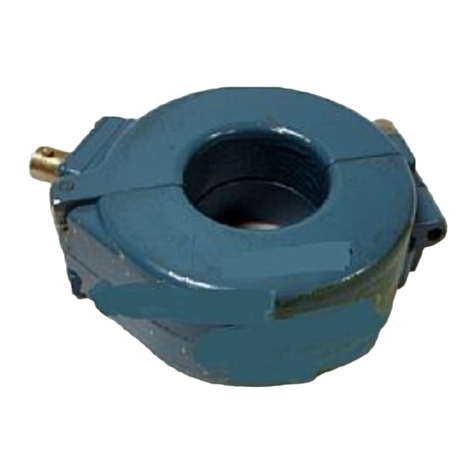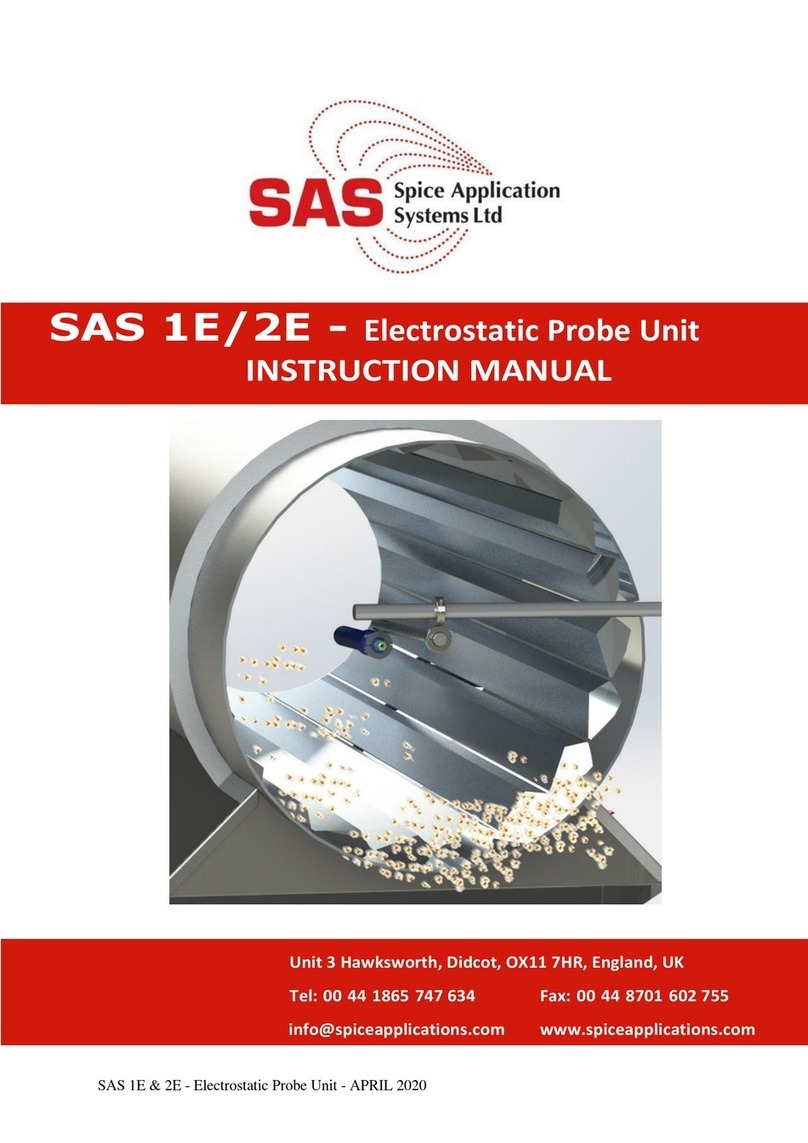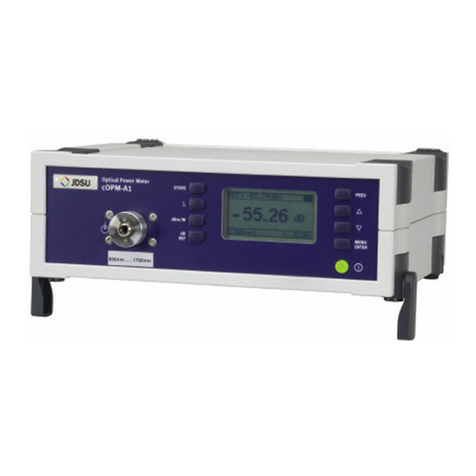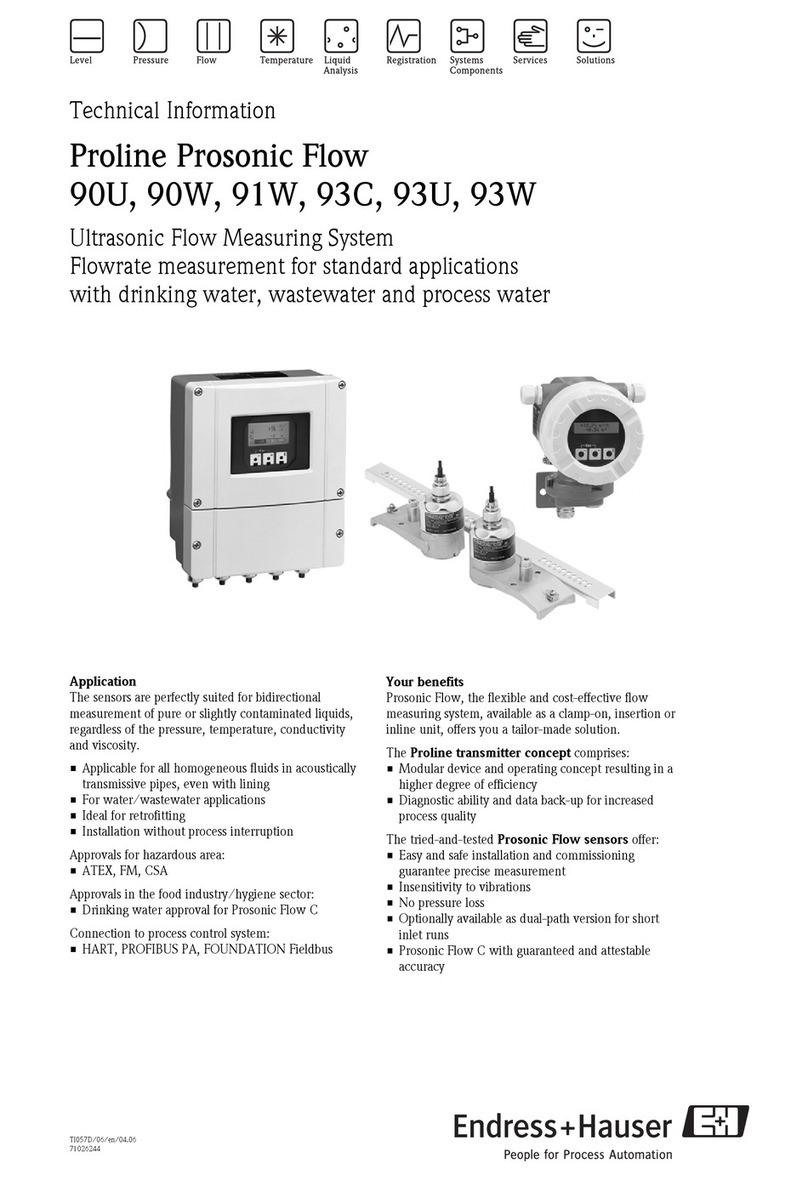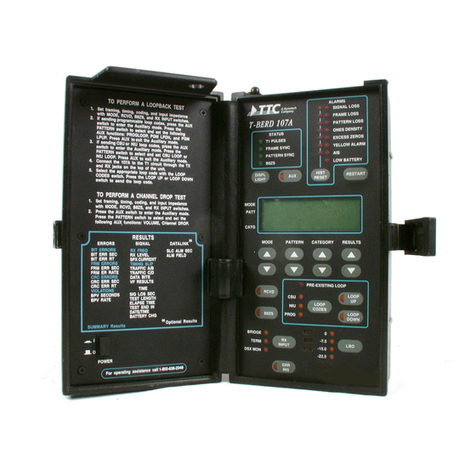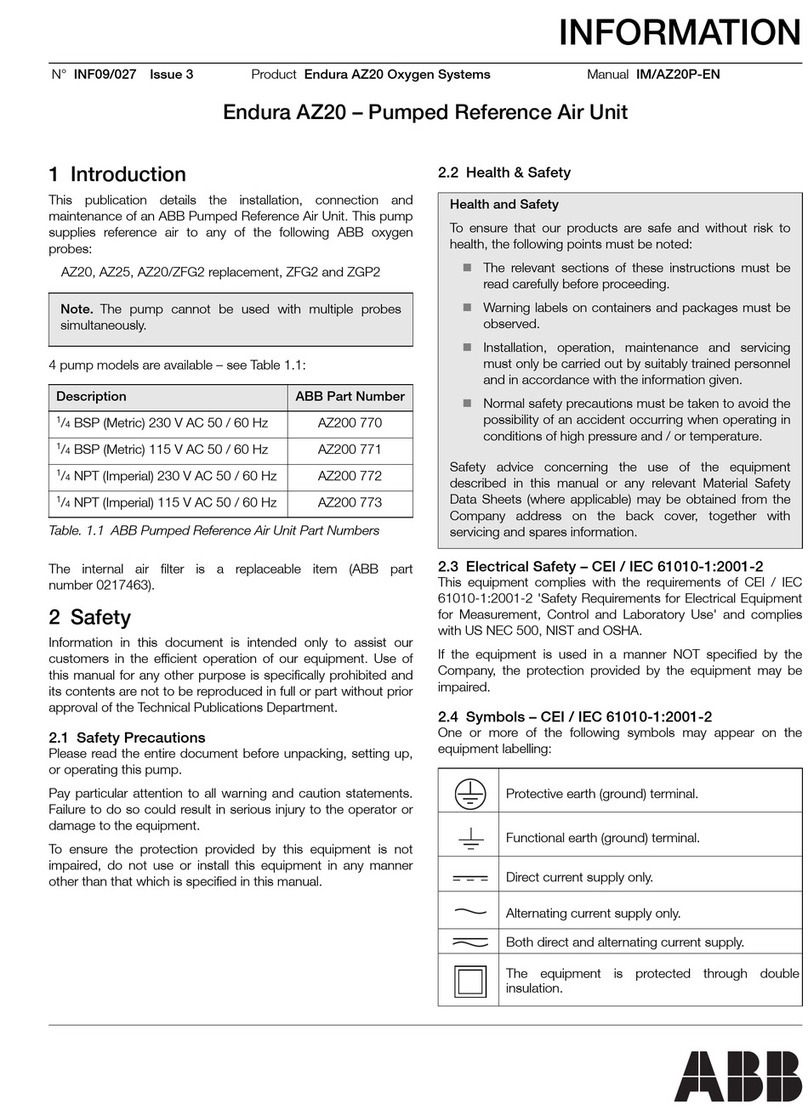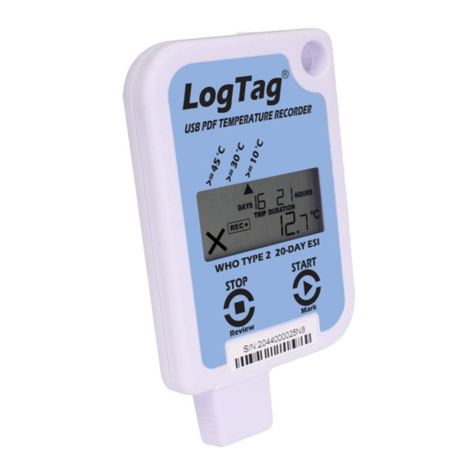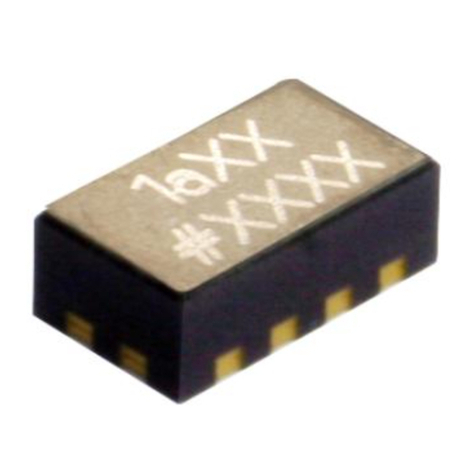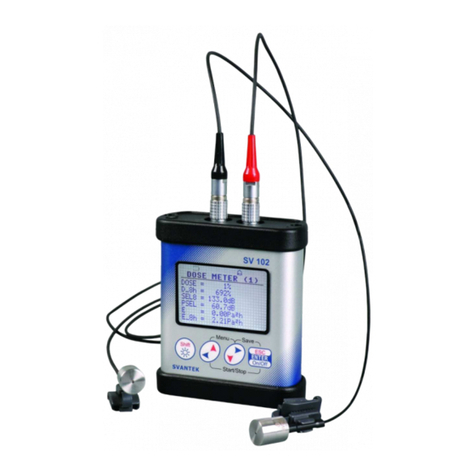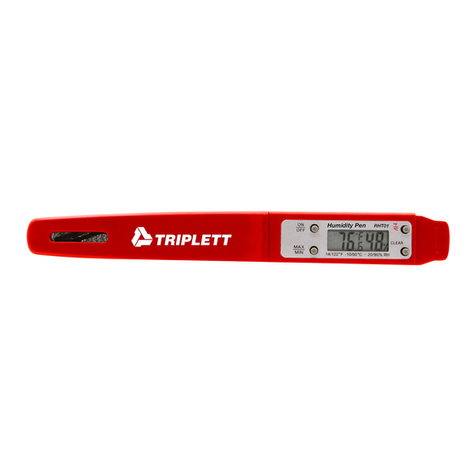Electro-Metrics EM-2115 User manual

INSTRUCTION MANUAL
INTERFERENCE
ANALYZER
MODEL EM-2115
(EMC-30)

INSTRUCTION MANUAL
THIS INSTRUCTION MANUAL AND ITS
ASSOCIATED INFORMATION IS PRO-
PRIETARY. UNAUTHORIZED REPRO-
DUCTION IS FORBIDDEN.
2002 ELECTRO-METRICS CORP.
INTERFERENCE ANALYZER
ELECTRO-METRICS
MODEL EM-2115
(EMC-30)
SERIAL NO: N/A
ELECTRO-METRICS CORPORATION
231 Enterprise Road, Johnstown, New York 12095
Phone: (518) 762-2600 Fax: (518) 762-2812
MANUAL REV. NO: EM2115-0102 ISSUE DATE: JANUAERY 01 2002

WARRANTY
This Model EM-2115 Interference Analyzer is warranted for a pe-
riod of 12 months (USA only) from date of shipment against defec-
tive materials and workmanship. This warranty is limited to the
repair of or replacement of defective parts and is void if unauthor-
ized repair or modification is attempted. Repairs for damage due to
misuse or abnormal operating conditions will be performed at the
factory and will be billed at our commercial hourly rates. Our esti-
mate will be provided before the work is started.

ELECTRO-METRICS EM-2115 TABLE OF CONTENTS
(EM2115-0.1-
i
)
TABLE OF CONTENTS
SECTION TITLE PAGE
0.1 Installation 0-1
0.1.1 Benchtop Operation 0-1
0.1.2 Rack Mounting 0-1
I Introduction And Specifications S1-1
1.1 Introduction S1-1
1.2 Receiver Specifications S1-2
II Operating Instructions S2-1
2.1 Operational Precautions S2-1
2.1.1 Power Source Selector S2-1
2.1.2 Tuning Mode Selection Switch S2-1
2.1.3 Input Signal Limits S2-1
2.2 Power Supply S2-2
2.2.1 Power Requirements S2-2
2.2.2 Power Source Selector S2-2
2.2.3 Fuse Specifications S2-3
2.2.4 Optional EM-2126 Battery/Charger Module S2-3
2.3 Operating Procedures S2-3
2.3.1 Initial Power Up Procedure S2-3
2.3.2 Pre-Operational Calibration S2-4
2.3.2.1 CW Calibration S2-4
2.3.3 Pre-Operational Check S2-4
2.4 Local Mode Of Operation S2-6
2.4.1 Amplitude And Frequency Measurement S2-6
2.4.2 Amplitude Accuracy Correction Factor S2-6
2.4.3 Input Attenuation Selection S2-8
2.4.3.1 Input Attenuation Selection Criteria S2-8
2.4.4 IF Bandwidth Selection S2-8
2.4.4.1 Bandwidth Selection Criteria S2-9
2.4.5 Signal Measurements S2-10
2.4.6 Detector Mode Selection S2-11
2.4.6.1 Peak Detector S2-12
2.4.6.2 Quasi-Peak Detector S2-14
2.4.6.2.1 Quasi-Peak Measurement Technique S2-15
2.4.6.3 RMS Detector S2-16
2.4.6.3.1 RMS Measurement Technique S2-17
2.4.6.3.2 RMS Value Of Radiation Field S2-17
2.4.6.4 Average Detector S2-18
2.4.6.4.1 Average Measurement Technique S2-18
2.4.6.5 Slideback Detector S2-18
2.4.6.5.1 Slideback Detector Aural (Audio)
Measurement Technique S2-19
2.4.7 Broadband/Narrowband Determination S2-20
2.5 Computer Operation S2-21
2.5.1 Equipment Setup S2-21
2.5.2 Bus Address S2-22
2.5.3 Remote Mode Of Operation S2-22
2.5.4 Local/Local Lockout Commands S2-23

ELECTRO-METRICS EM-2115 TABLE OF CONTENTS
(EM2115-0.1-
ii
)
TABLE OF CONTENTS
SECTION TITLE PAGE
2.5.5 EM-2115 Device Dependent Commands S2-23
2.5.6 Frequency Tuning S2-25
2.5.7 Amplitude And Frequency Read S2-25
2.5.8 Computer Software Available for EM-2115 S2-26
2.6 External X-Y Recorder Operation S2-26
2.6.1 EM-2115/X-Y Recorder Calibration S2-26
2.6.2 EM-2115/X-Y Recorder Operation S2-27
2.7 External Oscilloscope Operation S2-29
2.7.1 EM-2115 Oscilloscope Output Connectors S2-29
2.7.2 EM-2115/Oscilloscope Operation S2-30
III Performance Check S3-1
3.1 Introduction S3-1
3.2 When To Use Test Procedures S3-1
3.3 Preliminary S3-1
3.3.1 Precautions S3-1
3.3.2 Control Settings S3-2
3.3.3 Frequency Check Points S3-2
3.3.4 Signal Amplitude And Frequency Accuracy S3-3
3.4 Performance Test Procedures S3-3
3.4.1 CW Voltage Accuracy S3-3
3.4.2 Broadband Voltage Accuracy S3-4
3.4.3 Frequency Accuracy S3-5
3.4.4 Attenuator Accuracy S3-6
3.4.5 CW Sensitivity S3-7
3.4.6 Impulse Sensitivity S3-8
3.4.7 Bandwidth (3 dB) S3-9
3.4.8 Image Rejection S3-10
3.4.9 IF Rejection S3-12
3.4.10 Spurious Response S3-12
IV Service, Maintenance, And Calibration S4-1
4.1 Precautions S4-1
4.2 Instrument Access/Disassembly/Assembly S4-2
4.2.1 Top/Bottom Cover Removal S4-2
4.2.1.1 Top Cover Removal S4-2
4.2.1.2 Bottom Cover Removal S4-2
4.2.2 RF Tuner Assembly (A2) Removal S4-2
4.2.2.1 RF Tuner Top Cover Removal S4-3
4.2.3 Submodule Assembly Removal S4-4
4.2.3.1 Submoduel Assembly Disassembly/Assembly S4-5
4.2.4 Front Panel Assembly (A1) Removal S4-5
4.2.5 Prescaler Module (A12) Removal S4-6
4.2.6 Power Supply Assembly (A14) Removal S4-6
4.3 Preliminary S4-7
4.3.1 Work Conditions S4-7
4.3.2 Control Settings S4-7
4.4 Calibration/Alignment Procedures S4-8

ELECTRO-METRICS EM-2115 TABLE OF CONTENTS
(EM2115-0.1-
iii
)
TABLE OF CONTENTS
SECTION TITLE PAGE
4.4.1 Power Supply Verification S4-8
4.4.1.1 Regulated DC Voltage Checks S4-8
4.4.1.2 Power Supply Board A14A1 Adjustments S4-9
4.4.2 Detection/Metering Circuitry Adjustment/Verification S4-10
4.4.2.1 Signal Amplitude Digital Meter Adjustment/Verification S4-10
4.4.2.2 Detector Board A8 Verification S4-11
4.4.3 Log Detector Module A4 Adjustment/Verification S4-12
4.4.4 Narrowband (0.1) Filter Module A6
Adjustment/Verification S4-15
4.4.5 IF Amplifier Module A3 Adjustment/Verification S4-16
4.4.5.1 IF Amplifier Bandwidth Check/Adjustment S4-17
4.4.5.2 IF Amplifier Gain Check/Adjustment S4-19
4.4.6 Preamplifier Board A2A16A2 Adjustment/Verification S4-20
4.4.7 Tune Control Bd (A10) Adjustment/Verification S4-22
4.4.8 Tuning Regulator Board A2A16A2
Adjustment/Verification S4-23
4.4.9 Sweep Board A11 Adjustment/Verification S4-25
4.4.10 Frequency Display and Prescaler Verification S4-26
4.4.11 RF Tuner A2 Adjustment/Verification S4-29
4.4.11.1 Local Oscillator Level Adjustment S4-30
4.4.11.2 Stator Board A2A16A1 Mixer Adjustment/Verification S4-30
4.4.11.3 RF Frequency Bands 1-9 (A2A1-A2A9)
Adjustment/Verification S4-31
4.4.11.4 Mixer Null RF Frequency Ranges 1-9 S4-34
4.4.11.5 RF Frequency Bands 10-15 (A2A10-A2A15) S4-35

ELECTRO-METRICS EM-2115 TABLE OF CONTENTS
(EM2115-0.1-
iv
)
APPENDICES
APPENDIX TITLE PAGE
4A Troubleshooting Microprocessor Assembly A1A3 4A-1
4A-1.0 Introduction 4A-1
4A-2.0 Failure Diagnosis 4A-1
4A-3.0 Troubleshooting Techniques 4A-1
A Description Front Panel Controls A-1
A-1.0 Control Function A-1
A-2.0 Attenuator A-1
A-2.1 Attenuation Switches A-1
A-2.2 Attenuation Indicator A-1
A-3.0 Frequency Control A-2
A-3.1 Main Tuning Control A-2
A-3.2 Fine Tune Control A-2
A-3.3 Frequency Display A-2
A-3.4 Range Selector Switches A-2
A-3.4.1 Frequency Range Indicator A-2
A-4.0 AFC Switch A-2
A-5.0 Sweep Function Controls A-3
A-5.1 Scan Mode Switch A-3
A-5.1.1 Scan Mode Indicator A-3
A-5.2 Start Switch A-3
A-5.3 Scan Width Control A-4
A-5.4 Scan Rate Control A-4
A-5.5. Marker Switch A-5
A-6.0 Bandwidth Switch A-5
A-6.1 Bandwidth Indicator A-6
A-7.0 Detection Switch A-6
A-7.1 Detector Indicators A-7
A-8.0 Amplitude Indication A-7
A-8.1 Digital Meter A-8
A-8.2 Analog Meter A-8
A-9.0 Calibration Function A-8
A-9.1 CAL Switch A-8
A-10.0 Audio Function A-8
A-10.1 Audio Switch A-9
A-10.1.1 Audio Indicators A-9
A-10.2 Audio Volume Control A-9
A-11.0 Local Switch A-9
A-11.1 Remote Indicators A-10
A-12.0 Power Switch A-10
B Description Front/Rear Panel Connectors B-1
B-1.0 Description Front Panel Connectors B-1
B-1.1 Input Connector A1J1 B-1
B-1.2 Audio Output A1J2 B-1
B-2.0 Rear Panel Connectors B-1
B-2.1 PRE-IF Connector A13J10 B-1
B-2.2 POST IF Connector A13J10 B-1

ELECTRO-METRICS EM-2115 TABLE OF CONTENTS
(EM2115-0.1-
v
)
APPENDICES
APPENDIX TITLE PAGE
B-2.3 EM-2115 To Oscilloscope Connectors B-1
B-2.4 AM Video Connector A13J5 B-2
B-2.5 FM Video Connectors A13J6 B-2
B-2.6 X-Y Plotter Connector A13J3 B-2
B-2.8 Antenna Connector A13J1 B-2
B-2.7 GPIB Connector A13J4 B-2
B-2.9 Power Connector (A14J2 B-2
B-2.10 Battery Input Connector A14J3 B-3
C Function And Description C-1
C-1.0 Introduction C-1
C-2.0 Synopsis Of Receiver Operation C-1
C-3.0 Circuit Description C-2
C-4.0 A2 RF Tuner Module C-2
C-4.1 A2A16A6 RF Input Attenuator C-2
C-4.2 A2A16A5 IG Calibrator Assembly C-2
C-4.3 A2A16A1 Stator Board Assembly C-3
C-4.4 A2A1-A2A15 RF Frequency Range Bands C-3
C-4.5 A2A16A2 Preamplifier/Tuning Regulator Board C-4
C-4.6 A2A16A4 LO Amplifier Module C-5
C-5.0 A3 IF Amplifier Module C-5
C-6.0 A6 (0.1) Narrowband Filter Module C-7
C-7.0 A4 Log Detector Module C-7
C-8.0 A8 Detector Board C-8
C-9.0 A5 Discriminator Module C-9
C-10.0 A10 Tune Control Board C-10
C-11.0 A11 Sweep Board C-10
C-12.0 A9 Audio Amplifier Board C-11
C-13.0 A12 Prescaler Module C-12
C-14.0 A1A2 Front Panel Board C-12
C-15.0 A1A3 Microprocessor Board C-12
C-16.0 A16 Interface Board C-13
C-17.0 A15 Power Supply Filter Assembly C-14
C-18.0 A14 Power Supply C-14
D Broadband Conversion Factors D-1
E EM-2115 Accessory Items E-1
E-0.1 Standard Accessory Items E-1
E-1.0 Optional Accessory Items E-1
E-2.0 Antennas E-1
E-2.1 EM-6875 Remote Loop Antenna E-1
E-2.2 EM-6912A Biconical Antenna E-2
E-2.3 EM-6940 Log Conical Antenna E-6
E-2.4 EM-6950 Log Periodic Antenna E-7
E-2.5 EM-6960 Double Ridged Guide Antenna E-10
E-2.6 Em-6892 Remote Active Antenna E-11
E-2.7 EM-6893 Remote Vertical Antenna E-13
E-2.8 EM-6924 Tunable Dipole Antenna Set E-16

ELECTRO-METRICS EM-2115 TABLE OF CONTENTS
(EM2115-0.1-
vi
)
APPENDICES
APPENDIX TITLE PAGE
E-3.0 Probes E-18
E-3.1 EM-6981 Current Probe E-18
E-3.2 EM-6880/EM-6881/EM-6882 Magnetic Field Probes E-20
E-3.3 EM-6983 Line Probe E-22
E-3.4 Electrostatic Field Probe E-23
E-3.5 EM-6992 Near Field Probe Set E-23
E-4.0 Filters E-24
E-4.1 High/Low Pass Filters E-24
E-4.2 Tunable Rejection Filters E-25
E-5.0 Line Impedance Stabilization Networks E-25
E-5.1 LISNs Available For Use With EM-2115 E-25
E-6.0 CIG-25 E-26
E-7.0 EM-2116 Battery Pack/Charger E-27
E-8.0 EM-4206 Broadband Preamplifier E-28
E-9.0 EM-4205 Broadband Power Amplifier E-30
E-10.0 Additional Optional Accessory Items E-31
F Recommended Test Equipment F-1
G EM-2115 Replaceable Components G-1
G-1.0 Introduction G-1
G-2.0 Replaceable Assemblies G-1
G-3.0 EM-2115 Parts List G-2
G-3.1 Resistor Part Number Codes G-2
H Schematic Diagrams H-1

ELECTRO-METRICS EM-2115 TABLE OF CONTENTS
(EM2115-0.1-
vii
)
LIST OF TABLES
TABLE TITLE PAGE
1.1 EM-2115 Specifications S1-3
2.1 Typical Broadband Correction Factors Vs Bandwidth S2-11
2.2 Sample Time Control Settings Vs Dump Rate S2-13
2.3 CISPR Conversion Factors S2-15
2.4 IF Bandwidth Vs Frequency Difference For
Broadband/Narrowband Determination S2-21
2.5 Device Dependent Command Summary S2-23
4.1 Log Detector Signal Input Level Vs DC Output Voltage S4-14
4.2 Single Mode Sweep Times S4-26
4.3 ContinuousMode Sweep Times S4-26
4.4 Frequency Display Preset/LO Input Data S4-28
4.5 Microprocessor Board A1A3-J5 (Divide By 100)
Frequency Display Preset/LO Input Data S4-29
4.6 RF Frequency Ranges 1-9 Adjustments S4-33
4A.1 µP Common Failures: Symptoms VS Causes 4A-2
4A.2 µP Address Map 4A-5
4A.3 PIA Table Listing EM-2115 4A-6
G.1 Replaceable Assemblies G-1

ELECTRO-METRICS EM-2115 TABLE OF CONTENTS
(EM2115-0.1-
viii
)
LIST OF ILLUSTRATIONS
FIGURE TITLE PAGE
2.1 Correction Factor For Signals Near Noise S2-7
4.1 Front Panel EM-2115 S4-37
4.2 Rear Panel EM-2115 S4-39
4.3 Top View EM-2115 S4-41
4.4 Bottom View EM-2115 S4-43
4.5 EM-2115 Rear View, Power Supply Removed S4-45
4.6 A14 Power Supply Assembly S4-47
4.7 Rear Panel Antenna Connector S4-48
4.8 A13J3 Plotter Connector S4-49
4.9 EM-2115 Signal Level Chart S4-50
A.1 EM-2115 Front Panel A-13
B.1 EM-2115 Rear Panel B-5
B.2 Rear Panel Antenna Connector B-6
B.3 A13J3 Plotter Connector B-7
E.1 EM-6875 Typical Antenna Factor Chart E-4
E.2 EM-6912A Typical Antenna Factor Chart E-5
E.3 EM-6940 Typical Antenna Factor Chart E-8
E.4 EM-6950 Typical Antenna Factor Chart E-9
E.5 EM-6892 Typical Antenna Factor Graph E-14
E.6 EM-6893 Typical Antenna Factor Chart E-15
E.7 EM-6981 Typical Transfer Impedance Factor Chart E-19
FIGURE TITLE NUMBER
H.1 Impulse Generator (A2A16A5) C-6141-1A
H.2 RF Tuner/Stator P.C. Board (A2A16A1) R-8733A
H.3 RF Tuner Bands 1-9 (A2A1-A2A9) R-3416-P
H.4 RF Tuner Band 10 (A2A10) D-8727
H.5 RF Tuner Band 11 (A2A11)q D-8728
H.6 RF Tuner Band 12 (A2A12) D-8729-A
H.7 RF Tuner Band 13 (A2A13) R-8730-A
H.8 RF Tuner Band 14 (A2A14) R-8731-A
H.9 RF Tuner Band 15 (A2A15) R-8732-A
H.10 Preamplifier/Tuning Regulator P.C. Board (A2A16A2) R-8614-A
H.11 LO Outuput Amplifier (A2A16A4) B-8725
H.12 Interconnection Diagram RF Tuner (A2) D-8723
H.13 IF Amplifier (A3) D-9195
H.14 Narrowband Filter Module (A6)(0.1 NB Crystal Filter) R-4325-1
H.15 Log Amplifier Detector (A4) R-3779-1-S
H.16 Detector P.C. Board (A8) D-9185
H.17 Discriminator (A5) D-8658-A
H.18 Tune Control P.C. Board (A10) D-8616-A
H.19 Sweep P.C. Board (A11) R-8615-B

ELECTRO-METRICS EM-2115 TABLE OF CONTENTS
(EM2115-0.1-
ix
)
H.20 Audio Amplifier P.C. Board (A9) D-8871-B
H.21 Prescaler Module (A12) C-8619-B
LIST OF ILLUSTRATIONS
FIGURE TITLE NUMBER
H.22 Front Panel P.C. Board (A1A2) R-9182
H.23 Interface P.C. Board (A16) R-8631-C
H.24 Microprocessor P.C. Board (A1A3) R-8611-1
H.25 Interconnection Diagram R-8718-A
H.26 Power Supply Filter Assembly (A15) D-8634-B
H.27 Power Supply (A14) R-8625
H.28 High Voltage Converter C-8861
Note: For schematics Contact Electro-Metrics for availability.

ELECTRO-METRICS EM-2115 0.1 INSTALLATION
(EM2115-0.1-
i
)
SECTION 0.1
EM-2110
INSTALLATION
0.1 Installation
The EM-2110 is designed for either benchtop operation or installation in a con-
ventional 19-inch equipment rack.
0.1.1 Benchtop Operation
When operating the EM-2110 in a free-standing mode (i.e., benchtop operation)
allow sufficient clearance at the top, rear, and sides of the unit to permit effective convec-
tion cooling to occur. Do Not stack any equipment on top of the EM-2110, as this will
block the cooling holes in the top cover of the receiver. The operating environment of the
EM-2110 should be keep as cool as possible, not exceeding 30°C-35°C (86°F-95°F).
0.1.2 Rack Mounting
To rack mount the EM-2110, using slide mounts, use the following procedure.
a. Pry off the black decorative covers at each end of the handles.
b. Remove the one (1) 6-32 and one (1) 4-40 pan-head screws which secure
the handles to the unit.
c. Remove the handle mounting bases and spacers (each side).
d. Remove the handles and decorative shims (two each side, total: four).
e. Remove all flat-head screws from the side center bars except for the two
(2) screws near the front of the unit.
NOTE: Until the slide mounts are installed, the unit should be
handled with care as the case will be weakened with the
removal of the above hardware.
f. Secure the slide mounting assembly in the handle mounting groove using
the following flat-head screws from front to rear:
1) One (1) 6-32 X 3/8.
2) One (1) 6-32 X 9/16.
3) One (1) 6-32 X 1/2.

ELECTRO-METRICS EM-2115 0.1 INSTALLATION
(EM2115-0.1-
ii
)
4) One (1) 6-32 X 3/8.
5) One (1) 4-40 X 3/8.
NOTE: The left-hand slide mounting assembly contains a notch
in the front bracket for the RF Input Cable.
g. Install the slide assemblies to each side of the unit using six (6) 8-32 X 1/4
screws.
h. The unit is now ready for installation into a console or rack containing a
slide-mounting assembly.
i. To remove slide mounts and install handles, reverse the procedure given
above.
0.1.2.1 Rack Mounting, Environmental Considerations
When operating the EM-2110 as part of a rack-mounted system, either open or
enclosed, always provide sufficient cooling air to keep the operating temperature of the
EM-2110 from exceeding 30°C-35°C (86°F-95°F).

ELECTRO-METRICS EM-2115 1.0 INTRODUCTION/SPECIFICATIONS
(EM2115S1-1)
SECTION I
EM-2115
INTRODUCTION AND SPECIFICATIONS
1.1 Introduction
The EM-2115 Interference Analyzer performs emission and susceptibility testing to MIL-
STD-461 and MIL-STD-462, CISPR, plus other applicable military, government, and commer-
cial (both domestic and international) standards from 9 kHz to 1000 MHz.
A built-in microprocessor controls the operation of the receiver through information
keyed in by the front panel controls. In addition, front panel controls are directly accessible from
a computer through the IEEE-488 General Purpose Interface Bus (GPIB).
LED displays provide accurate readings of tuned frequency and signal strength. The fre-
quency measurement is accurate to ±0.1% and the amplitude measurement, which includes atten-
uation, is accurate to ±2 dB. Separate LED displays enhance the main displays indicating the fre-
quency range in use and the level of attenuation. For ease in tuning, the digital meter is augment-
ed by a front-panel analog meter. In addition, a Beat Frequency Oscillator (BFO) is included to
aid in tuning CW signals.
Advanced detector circuits provide true average, direct peak, quasi-peak, true rms, and
slideback.
a. "True Average" Detector: The "True Average" detector provides the true time-
averaged value of the amplitude of any signals appearing at the RF input that are
within the IF band pass. When used in conjunction with the Peak or RMS Detec-
tors, the modulation of modulated CW signals and the duty cycle of impulsive
signals can be approximated.
b. Direct Peak Detector: The Direct Peak Detector measures the vector sum peak of
the voltage within the selected IF band pass of the receiver. A sample and hold
circuit, having a rise time of less than 2 µs plus an associated dump circuit to reset
the detector for the next peak reading, is used to make the measurement.
c. Quasi-Peak Detector: The Quasi-Peak Detector circuit results in measurements
which conform to ANSI C63.2-1980, CISPR Publication 16, and related VDE re-
quirements.
d. "True Rms" Detector: The "True RMS" detector measures the time-averaged
true rms value of the signal within the selected IF band pass, providing an indica-
tion of the average power at the input of the receiver.
e. Slideback Peak Detector: The Slideback Peak detector is an envelope detector
with the addition of a threshold level control. If more than one broadband signal is
present within the selected IF band pass of the receiver, the peak amplitude of
each signal can be measured using either an aural (audio--headphones) or visual

ELECTRO-METRICS EM-2115 1.0 INTRODUCTION/SPECIFICATIONS
(EM2115S1-2)
(log video presentation--external oscilloscope) method in conjunction with the
front panel digital meter.
The bandwidths of the EM-2115 have been tailored to conform fully with MIL-STD-
462D and the October 1984 draft of British DEF-STAN 59-41 (Part 3)/2, as well as ANSI C63.2.
A choice of three bandwidths is available at each frequency.
Calibrated Spectrum Analyzer-type presentations are available by connecting the receiver
to a conventional oscilloscope. Sweep features include variable scan rate and variable dispersion
(0.1% to 20%, 100% at click stop, of the octave band selected). Appropriate outputs for X-Y
plotting utilizing the above sweep features are also available.
The optional EM-2126 Battery/Charger Module permits field testing at remote locations
such as site surveys, field strength measurements near powerlines, and antenna measurements.
1.2 Receiver Specifications
The electrical and general specifications for the EM-2115 Interference Analyzer are given
in Table 1.1.

ELECTRO-METRICS EM-2115 1.0 INTRODUCTION/SPECIFICATIONS
(EM2115S1-3)
TABLE 1.1
EM-2115 SPECIFICATIONS
FUNCTION/CHARACTERISTICS DESCRIPTION/PERFORMANCE
Equipment: EM-2115 Interference Analyzer
Type: Superheterodyne
Final IF Frequencies: Bands 1-7: 175 kHz.
Bands 8-10: 1.6 MHz.
Bands 11-15: 8.7 MHz.
IF Bandwidths: Refer to the following table.
SPECIFICATION LIMITS
6 dB IF BANDWIDTH
FREQUENCY RANGE
(MHz)
IF BANDWIDTHS
SPECIFICATION LIMITS*
0.009-0.150
(1-3)
200 Hz +20/-30 Hz
1.0 kHz ±100 Hz
10 kHz**
0.120-1.1
(4-6)
1.0 kHz ±100 Hz
9.0 kHz ±1.0 kHz
200 Hz**
1.1-30.0
9.5 kHz ±500 Hz
1 kHz**
100 kHz**
25.0-1000.0
(11-15)
105 kHz ±5 kHz
10 kHz**
1 MHz**
NOTE: * Specifications given are valid only for the
stated frequency range.
** IF Bandwidths available for use, nominal
bandwidth only. No specifications apply.
Frequency Range: 9 kHz-1 GHz.

ELECTRO-METRICS EM-2115 1.0 INTRODUCTION/SPECIFICATIONS
(EM2115S1-4)
TABLE 1.1 CONT'D
EM-2115 SPECIFICATIONS
FUNCTION/CHARACTERISTICS DESCRIPTION/PERFORMANCE
RF Band Frequency Ranges: FREQ. RANGE FREQ.
(MHz)
1 0.009-0.035
2 0.035-0.075
3 0.070-0.150
4 0.120-0.250
5 0.250-0.500
6 0.5-1.1
7 1.1-2.4
8 2.4-5.5
9 5.5-12.5
10 12.5-30.0
11 25-50
12 50-100
13 100-200
14 200-500
15 500-1000
RF Band Selection: Dual pushbutton, 8-digit LED display indicates
actual frequency range covered.
Frequency Display: 6 Digit ½-inch LED.
Frequency Accuracy: ±0.1% ±1 count ±0.2 resolution BW.
Frequency Tuning: Dual 10-turn coarse and 100-turn medium per
band.
Fine Tune Control: 0.1% of Frequency Range, nominal.
Input Impedance: 50
, nominal.
RF Input Connector: Type TNC.
AFC: Selectable by front panel switch.
IF, Image, Spurious Rejection: 60 dB typical, 45 dB worst case.
Gain Flatness: ±1 dB typical, ±3 dB worst case.
Receiver Sensitivity vs Bandwidth: Refer to Table 1.2 page 1-
Voltage Measurement Range: 0.01
V to 1 V (160 dB), 60 dB display range
plus 100 dB of attenuation.
Voltage Accuracy: ±2 dB.

ELECTRO-METRICS EM-2115 1.0 INTRODUCTION/SPECIFICATIONS
(EM2115S1-5)
TABLE 1.1 CONT'D
EM-2115 SPECIFICATIONS
FUNCTION/CHARACTERISTICS DESCRIPTION/PERFORMANCE
Amplitude Display: 3-digit ½-inch LED with 1 dB resolution plus
uncalibrated 2-inch analog meter for ease in tun-
ing.
Detector Functions
Peak: Direct-peak response, calibrated in terms of rms
equivalent sinewave. Associated dump circuitry
controls sample time.
Quasi-Peak (CISPR): Refer to Table 1.4, Page 1-
Average: Video averaging,nominal 150 ms time constant.
Crest Factor: 50 dB minimum.
RMS: True rms of detected video signal, nominal 150
ms time constant.
Crest Factor: 30 dB minimum.
Slideback: Metered threshold biased envelope detector for
visual or aural extinction of peak levels.
Calibrator: Impulse generator, 9 kHz-1000 MHz, nominal 80
Hz rate. Automatically activated when Calibra-
tion switch is pushed. Digital amplitude display
automatically compensated.
Spectrum Analysis Controls: For driving conventional oscilloscope or X-Y
plotter.
Three modes: Manual, Continuous, or single
sweep with variable rate and dispersion.
Sweep times 0.01 to 3000 seconds based on con-
trol settings and band selected, with each setting
variable over a 10:1 range. Dispersion is variable
from 0.1% to 20% (100% at click stop) or the
band selected.
GPIB Interface: IEEE Std. 488-1978.

ELECTRO-METRICS EM-2115 1.0 INTRODUCTION/SPECIFICATIONS
(EM2115S1-6)
TABLE 1.1 CONT'D
EM-2115 SPECIFICATIONS
FUNCTION/CHARACTERISTICS DESCRIPTION/PERFORMANCE
Additional Outputs:
Post IF: Bands 1-10: 3 mVrms into 50
.
Bands 11-15: 1 mVrms into 50
.
Pre IF: 1 mV nominal into 50
.
AM Video: 50 mVpk into 91
.
FM Video: 100 mVpk into 91
.
Audio: 10 mW into 8
.
Blanking: 5 Volt pulse selectable for positive or negative
polarity. Factory set to +5 V.
Horizontal: 0 to 1.5 v nominal into 1 k
or greater.
Vertical: 0 to 1.5 v nominal into 1 k
or greater for 60 dB.
Selectable between peak, quasi-peak, rms, aver-
age, or slideback. Selectable marker for spec-
trum analysis.
Antenna Control Connector: Provides control of EM-6875, EM-6893, EM-
2505.
Plotter Outputs: Y1: Selectable peak, Quasi-peak, rms, average,
or slideback via detector switch; 0.0 to 1.5 VDC
into 1 k
or greater.
Y2: True peak value of an input signal; 0.0 to 1.5
VDC into 1 k
or greater.
X: Voltage proportional to frequency, 0.0 to 1.5
VDC into 1 k
or greater.
Pen Lift: TTL compatible open collector. GND
closure for pen drop.
Physical Characteristics
Size: Height: 178 mm (7").
Width: 425 mm (16¾").
Length: 571 mm (22¼")
(less handles)
Table of contents
Other Electro-Metrics Measuring Instrument manuals
Popular Measuring Instrument manuals by other brands

Omega Engineering
Omega Engineering FTB100 Series user guide

CORNING
CORNING ONE HEU Quick installation sheet
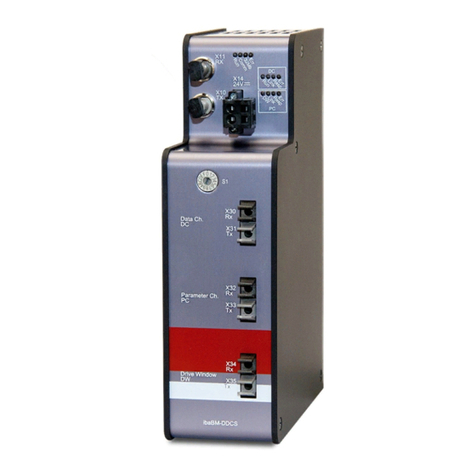
IBA
IBA ibaBM-DDCS manual

WINYCAM
WINYCAM Insight FX Air user manual
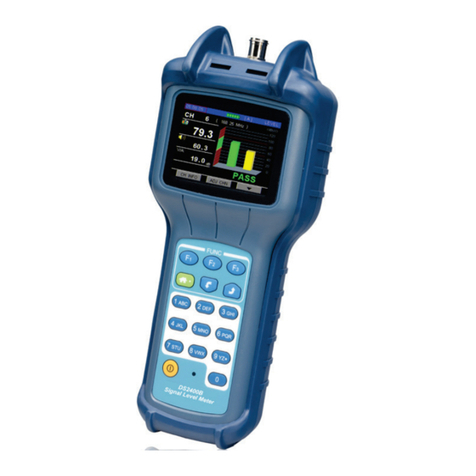
Deviser
Deviser DS2400B Operation manual

Precision Digital Corporation
Precision Digital Corporation ProtEX-MAX PD8 Series instruction manual
